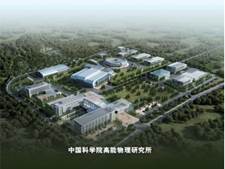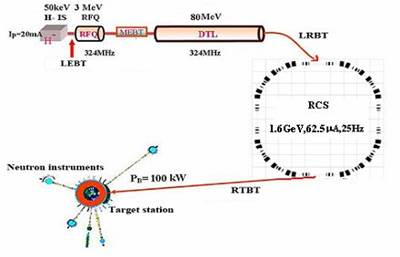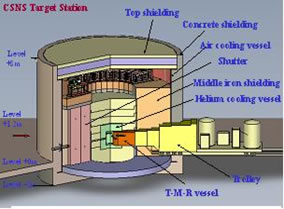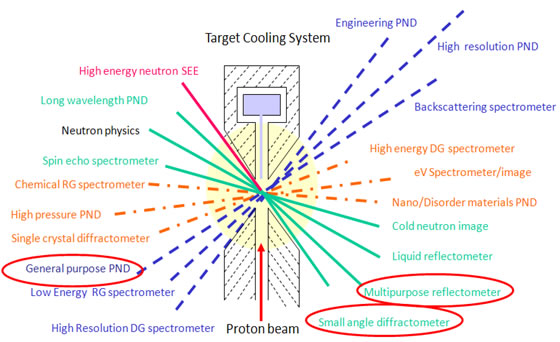 China Spallation Neutron Source(CSNS)locates at Dongguan, Guangdong province. It is about 85 km from Guangzhou and about 125 km from Hongkong. CSNS is a new branch of Institute of High Energy Physics(IHEP) of the Chinese Academy of Science(CAS), and the first large scientific facility in the southern China.
China Spallation Neutron Source(CSNS)locates at Dongguan, Guangdong province. It is about 85 km from Guangzhou and about 125 km from Hongkong. CSNS is a new branch of Institute of High Energy Physics(IHEP) of the Chinese Academy of Science(CAS), and the first large scientific facility in the southern China.
CSNS consists of an H- linac, a proton rapid cycling, a tungsten target, three first-phase instruments and corresponding facilities. It is designed to accelerate proton beam pulses to 1.6 GeV kinetic energy at 25 Hz repetition rate, striking a solid metal target to produce spallation neutrons. The accelerator is designed to deliver a beam power of 100 kW with the upgrade capability to 500 kW by raising the linac output energy and increasing the beam intensity. The phase I and phase II design indices of CSNS are shown in Table 1.

Table 1. CSNS design parameters
| Project phase |
I |
II |
|
Beam ave. power, KW |
100 |
500 |
|
Proton energy, GeV |
1.6 |
1.6 |
|
Ave. current, I, μA |
62.5 |
312.5 |
|
Repetition rate, Hz |
25 |
25 |
|
Proton per pulse, 1013 |
1.63 |
|
|
Linac energy, MeV |
80 |
250 |
|
Target material |
Tungsten |
Tungsten |
|
No. Moderators |
3 |
3 |
|
No. neutron instruments |
3 |
|
The experimental system includes the target, three neutron moderators, reflectors, shielding, utilities and maintenance systems.
 The target material is Tungsten with water cooling. The target is surrounded by a 1m in diameter heavy-water cooled beryllium and iron reflector, with two moderators (one decoupled ambient water moderator plus one decoupled and poisoned supercritical hydrogen cryogenic moderator) above the target and one coupled supercritical hydrogen cryogenic moderator below the target. The target station will take 100kW, 1.6GeV proton beam from the accelerator, and convert into short pulse, lower-energy neutron beam. The fast neutron will be moderated by coupled, decoupled H2 (20K) and water (300K) moderators and then transported down the beam tubes to the neutron instrument hall for neutron scattering experiments.
The target material is Tungsten with water cooling. The target is surrounded by a 1m in diameter heavy-water cooled beryllium and iron reflector, with two moderators (one decoupled ambient water moderator plus one decoupled and poisoned supercritical hydrogen cryogenic moderator) above the target and one coupled supercritical hydrogen cryogenic moderator below the target. The target station will take 100kW, 1.6GeV proton beam from the accelerator, and convert into short pulse, lower-energy neutron beam. The fast neutron will be moderated by coupled, decoupled H2 (20K) and water (300K) moderators and then transported down the beam tubes to the neutron instrument hall for neutron scattering experiments.

The CSNS experimental hall accommodates 20 neutron scattering instruments. The first-phase programming includes General Purpose Powder Diffractometer, Multipurpose Reflectometer and Small Angle Diffractometer. CSNS welcome user communities to invest in dedicated neutron instruments. CSNS construction started in 2011 and the full operation for users is foreseen in spring 2018.